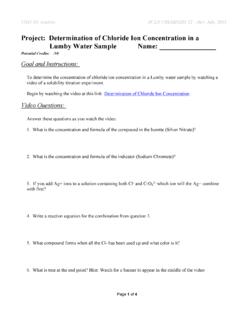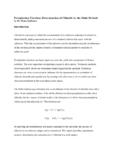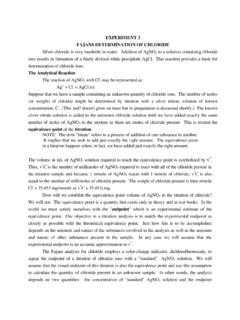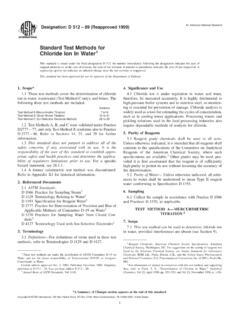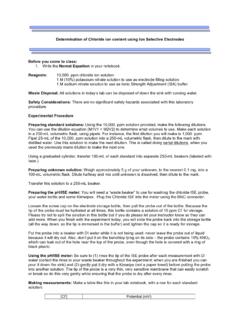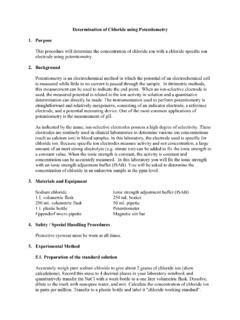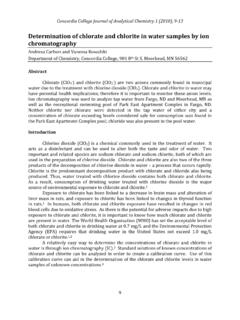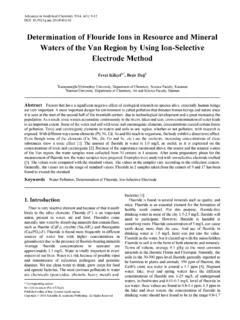Transcription of Gravimetric Analysis of Chloride
1 Chemistry 321L ManualPage 16 Recommended procedure foroven drying of crucibles,weighing bottles, Analysis of ChlorideI. IntroductionThe amount of Chloride ion in a substance can be determined by precipitating the solublechloride ion present with silver ion. The amount of Chloride ion present will be related to themass of silver Chloride formed. Ag+ (aq) + Cl- (aq) 6 AgCl (s)II. ProcedureA. Preparation of Filter Crucibles (Sintered-Glass)1. Use four filter crucibles of medium (M) porosity. Do not use crucibles marked C forcoarse Previously, the crucibles have been used to filter silver Chloride (purple or gray,ammonia soluble).
2 First, remove any bulk precipitate with a rubber policeman anddispose of it in a "Silver Collection" jar. Follow this with chemical cleaning. To removesilver Chloride , invert the crucibles in a large beaker in a fume hood and add one or twomL of concentrated ammonia to each. Allow to soak until clean. Carefully remove thecrucibles from the beaker and soak in water before removing from the fume hood. Setup a suction filtration apparatus and wash the crucible several times with water andfinally with deionized water. Empty the suction flask before proceeding. Stains that arenot removed by this cleaning process should not interfere with your , in pencil, each crucible on the frosted glass Dry the crucibles in an oven at 120EC for about 1 hour, usinga beaker, glass hooks, and watch glass (see figure).
3 A ribbedwatch glass can be used in place of the glass Remove the dried crucibles from the oven and let them coolfor about one minute on the counter top. With clean crucibletongs transfer the crucibles to the desiccator. After allowingthe crucibles to cool to room temperature for 30 minutes,weigh accurately. Repeat the drying operation for 1/2 hourand again determine the crucible mass. Continue this dryingand weighing procedure until each crucible mass is constantwithin mg. Since the mass of AgCl precipitated will beapproximately 600 mg, this represents a relative error of less than 1 ppth. When themasses obtained for a given crucible no longer show any particular trend (the valuesmay fluctuate up and down), take the average of these values to be the 'true' 321L ManualPage 17B.
4 Precipitation Procedure1. Dry the unknown Chloride in a weighing bottle (with top off in a covered beaker as wasdone for the crucibles) at 120EC for 2 hours while preparing the filter crucibles. Storethe dried unknown in a desiccator with the weighing bottle top in place. Weighaccurately 4 samples of about g (to four significant figures) each into clean 400-mLbeakers numbered the same as the crucibles. (The samples only need to be g 15%.)2. Add 150 mL of Chloride -free deionized water and acidify with 1 mL of 6 M HNO3. a separate stirring rod for each beaker, and leave it in the beaker throughout Assume the sample is pure sodium Chloride and calculate a theoretical maximumvolume of M silver nitrate needed to precipitate the Chloride ion.
5 Prepare therequired volume (plus about 10% excess) of M AgNO3 from M AgNO3 bydilution. Store the M AgNO3 solution in your brown reagent slowly, with stirring, the theoretical maximum volume (including the 10% excess)of M silver nitrate to each sample. Adjust this volume accordingly if the samplemass is significantly different than g. Note the volume of M AgNO3 added. Store your samples covered in your locker until the next Once the precipitate has coagulated on the bottom of the beaker so that the upperportion of the solution is clear, test for complete precipitation of Chloride by addinga few drops of M silver nitrate and observing if additional precipitate appears.
6 If itdoes, add more M silver nitrate solution (5% of the initial amount), stir thoroughlyand store covered in your locker until next period. Small particles will form on thebeaker walls and some will float on the surface. After sufficient coagulation, test againfor complete precipitation. C. Filtration and Weighing1. Prepare a wash solution by adding mL of 6 M nitric acid to 200 mL of deionizedwater. You may want to put this solution into your wash bottle for Place a weighed filter crucible in the suction filtration apparatus and apply gentlesuction. Decant the supernatant solution from the corresponding beaker through thecrucible, retaining the precipitate in the beaker.
7 Add about 10 mL of the wash solutionto the beaker with the retained precipitate and agitate to wash the precipitate. Let itsettle, and decant again through the crucible. Repeat 321L ManualPage 183. Now bring the precipitate onto the filter, using small portions of the wash solution fortransfer. Remove any solid particles adhering to the beaker with a rubber the precipitate in the crucible with several 5-mL portions of wash solution. Collectabout 1 mL of the last washing in a test tube and test it for silver ion by adding adrop of 6 M HCl. Wash again, if a precipitate is noted. When the filtrate in the filterflask tests negative for silver ion, it indicates that all excess AgNO3 adsorbed on thesurface of the precipitate has been removed by the washing and replaced by adsorbed HNO3 causes no error since it will be volatilized during the drying of Completely drain each crucible with strong suction.
8 Then place the crucibles withprecipitate into an oven and dry to constant mass as in the earlier procedure ( ).5. At the conclusion of the experiment, place the precipitate in a "Silver Collection" jarand clean your crucibles by dissolving any remaining AgCl precipitate in 5-10 mL ofconcentrated NH3(aq) (do this in a fume hood).III. CalculationsCompute the Gravimetric factor for converting mass of precipitate to mass of Chloride . From themasses of the crucibles with and without precipitate, calculate the masses of silver chlorideobtained. Using the Gravimetric factor, calculate the mass of Chloride in each sample ofunknown and the corresponding mass percent Chloride .
9 If one of the results appearsquestionable, test it for rejection. The precision of your results should be 1-3 ResultsReport each result, the mean and RMD of the mass percent Chloride in your sample, using theappropriate unknown report form, to the instructor.










